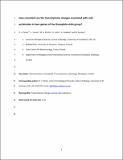Files in this item
How consistent are the transcriptome changes associated with cold acclimation in two species of the Drosophila virilis group?
Item metadata
| dc.contributor.author | Parker, D. J. | |
| dc.contributor.author | Vesala, L. | |
| dc.contributor.author | Ritchie, M. G. | |
| dc.contributor.author | Laiho, A. | |
| dc.contributor.author | Hoikkala, A. | |
| dc.contributor.author | Kankare, M. | |
| dc.date.accessioned | 2016-01-13T15:40:05Z | |
| dc.date.available | 2016-01-13T15:40:05Z | |
| dc.date.issued | 2015-07 | |
| dc.identifier | 200222428 | |
| dc.identifier | 54244db5-c9a4-470a-a4ed-6203efd8e842 | |
| dc.identifier | 000356024900003 | |
| dc.identifier | 84930868700 | |
| dc.identifier | 000356024900003 | |
| dc.identifier.citation | Parker , D J , Vesala , L , Ritchie , M G , Laiho , A , Hoikkala , A & Kankare , M 2015 , ' How consistent are the transcriptome changes associated with cold acclimation in two species of the Drosophila virilis group? ' , Heredity , vol. 115 , no. 1 , pp. 13-21 . https://doi.org/10.1038/hdy.2015.6 | en |
| dc.identifier.issn | 0018-067X | |
| dc.identifier.other | ORCID: /0000-0001-7913-8675/work/46761147 | |
| dc.identifier.uri | https://hdl.handle.net/10023/8014 | |
| dc.description | This work was financially support by a Marie Curie Initial Training Network grant, “Understanding the evolutionary origin of biological diversity” (ITN-2008–213780 SPECIATION), grants from the Academy of Finland to A.H. (project 132619) and M.K. (projects 268214 and 272927), a grant from NERC, UK to M.G.R. (grant NE/J020818/1), and NERC, UK PhD studentship to D.J.P. (NE/I528634/1). | en |
| dc.description.abstract | For many organisms the ability to cold acclimate with the onset of seasonal cold has major implications for their fitness. In insects, where this ability is widespread, the physiological changes associated with increased cold tolerance have been well studied. Despite this, little work has been done to trace changes in gene expression during cold acclimation that lead to an increase in cold tolerance. We used an RNA-Seq approach to investigate this in two species of the Drosophila virilis group. We found that the majority of genes that are differentially expressed during cold acclimation differ between the two species. Despite this, the biological processes associated with the differentially expressed genes were broadly similar in the two species. These included: metabolism, cell membrane composition, and circadian rhythms, which are largely consistent with previous work on cold acclimation/cold tolerance. In addition, we also found evidence of the involvement of the rhodopsin pathway in cold acclimation, a pathway that has been recently linked to thermotaxis. Interestingly, we found no evidence of differential expression of stress genes implying that long-term cold acclimation and short-term stress response may have a different physiological basis. | |
| dc.format.extent | 9 | |
| dc.format.extent | 1021347 | |
| dc.language.iso | eng | |
| dc.relation.ispartof | Heredity | en |
| dc.subject | Differential expression analysis | en |
| dc.subject | Northern house mosquito | en |
| dc.subject | Large gene lists | en |
| dc.subject | Biological-membranes | en |
| dc.subject | Stress tolerance | en |
| dc.subject | Culex-pipiens | en |
| dc.subject | Chill-coma | en |
| dc.subject | Temperature | en |
| dc.subject | Melanogaster | en |
| dc.subject | Myoinositol | en |
| dc.subject | QH301 Biology | en |
| dc.subject.lcc | QH301 | en |
| dc.title | How consistent are the transcriptome changes associated with cold acclimation in two species of the Drosophila virilis group? | en |
| dc.type | Journal article | en |
| dc.contributor.sponsor | NERC | en |
| dc.contributor.sponsor | NERC | en |
| dc.contributor.institution | University of St Andrews. School of Biology | en |
| dc.contributor.institution | University of St Andrews. Centre for Biological Diversity | en |
| dc.contributor.institution | University of St Andrews. Institute of Behavioural and Neural Sciences | en |
| dc.identifier.doi | 10.1038/hdy.2015.6 | |
| dc.description.status | Peer reviewed | en |
| dc.identifier.grantnumber | NE/E015255/1 | en |
| dc.identifier.grantnumber | NE/J020818/1 | en |
This item appears in the following Collection(s)
Items in the St Andrews Research Repository are protected by copyright, with all rights reserved, unless otherwise indicated.

